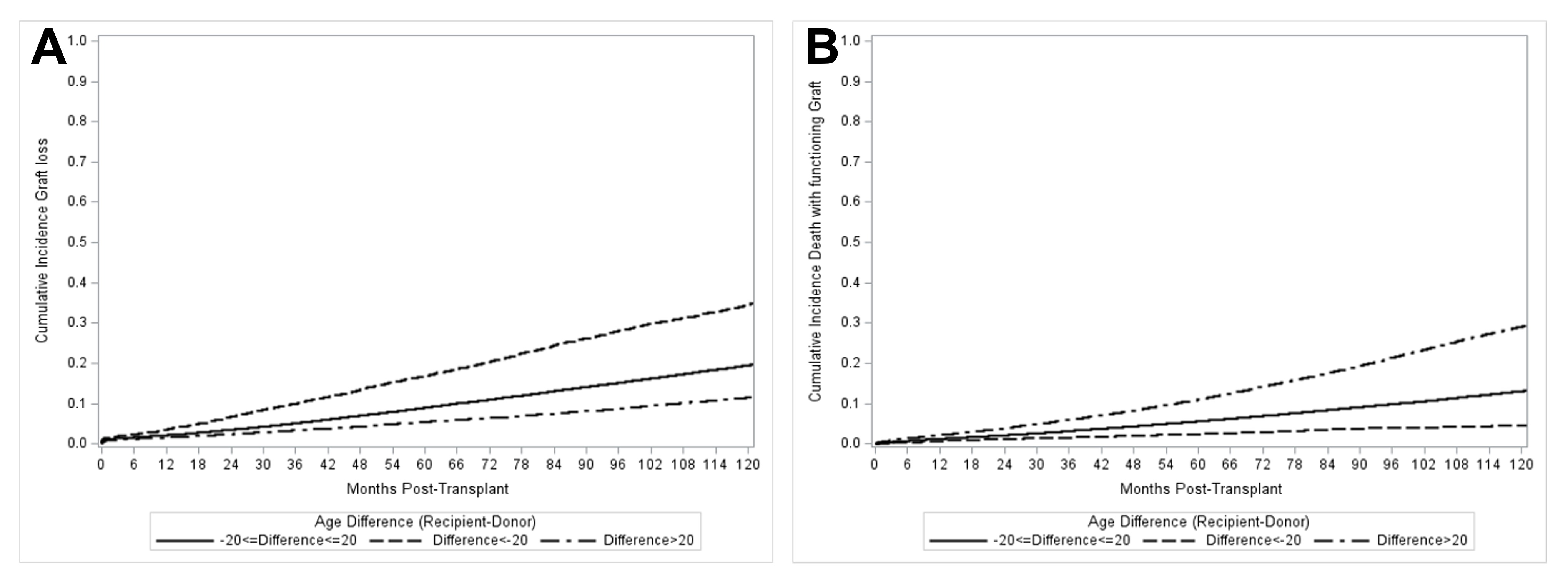Impact of Donor-Recipient Age Discrepancy in Living Donor Kidney Transplantation – The Need for Better Matching
1Surgery, Duke University Medical Center, Durham, NC, 2Surgery, East Carolina University, Greenville, NC
Meeting: 2022 American Transplant Congress
Abstract number: 1715
Keywords: Age factors, Kidney transplantation, Living donor
Topic: Clinical Science » Kidney » 42 - Kidney Living Donor: Selection
Session Information
Session Name: Kidney Living Donor: Selection
Session Type: Poster Abstract
Date: Tuesday, June 7, 2022
Session Time: 7:00pm-8:00pm
 Presentation Time: 7:00pm-8:00pm
Presentation Time: 7:00pm-8:00pm
Location: Hynes Halls C & D
Session Information
Session Time: 5:30pm-7:00pm
 Presentation Time: 5:30pm-7:00pm
Presentation Time: 5:30pm-7:00pm
Location: Hynes Hall C
*Purpose: The Kidney Allocation System (KAS) was implemented in 2014 to address donor-recipient matching in deceased donor kidney transplantation, with the goal of maximizing life-years of kidney grafts. Here, we aimed to analyze the effect of donor-recipient age matching on post-transplant recipient outcomes in living donor kidney transplantation (LDKT).
*Methods: Characteristics of LDKT donor-recipient pairs in the United States from 2000-2019 were extracted from the UNOS database. A multivariable Cox proportional hazards model was used to evaluate the association of recipient-donor age difference with risks of death-censored graft loss and death with functioning graft. Recipient-donor age difference was defined for analysis as follows: difference > +20 years, difference < -20 years, and a reference group of age difference within +/- 20 years. Hazard ratios and 95% confidence intervals are provided as measures of strength of association and precision, respectively.
*Results: A total of 111,407 LDKTs were performed in the study timeframe. The mean donor and recipient age increased annually from 39.8 and 44.4 years, respectively, in 2000 to 44.3 and 50.6 years in 2019. Compared to the reference group, younger recipients of older donors experienced an increased risk of death-censored graft loss [HR 1.94 (95% CI 1.86-2.03), p<.0001] while older recipients of younger donors had a decreased risk of death-censored graft loss [HR 0.60 (95% CI 0.58-0.63), p<.0001] (Fig.1A). In analyzing death with functioning graft, the opposite results were observed: younger recipients of older donors experienced decreased risk of death [HR 0.37 (95% CI 0.33-0.41), p<.0001] while older recipients of younger donors had increased risk of death [HR 2.40 (95% CI 2.32-2.48), p<.0001] compared to the reference group (Fig.1B).
*Conclusions: In our analysis of LDKT, we demonstrate significant unrealized life years when elderly recipients receive a kidney from a donor more than 20 years younger. Novel methods to encourage wider participation of compatible pairs in living donor exchange programs need to be developed to address these findings.
Figure 1: Cumulative incidence of death-censored graft loss (A) and death with functioning graft (B) after LDKT stratified by (recipient-donor) age difference.
To cite this abstract in AMA style:
Prabhu NK, Villani V, Samy KP, Sudan D, Ravindra K, Irish W. Impact of Donor-Recipient Age Discrepancy in Living Donor Kidney Transplantation – The Need for Better Matching [abstract]. Am J Transplant. 2022; 22 (suppl 3). https://atcmeetingabstracts.com/abstract/impact-of-donor-recipient-age-discrepancy-in-living-donor-kidney-transplantation-the-need-for-better-matching/. Accessed December 27, 2025.« Back to 2022 American Transplant Congress

